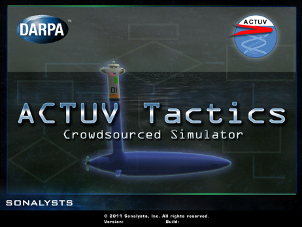Can a New Sub Chaser Learn From the 'Crowd'?

Anti-submarine warfare tactics developed by anonymous gamers today could be part of the “brains” of an unmanned, autonomous enemy sub tracker now under development for the U.S. Navy.
The Defense Advanced Research Projects Agency (DARPA) has released to the public a simulation program designed to work with “Dangerous Waters,” a popular computer game from Connecticut-based Sonalysts Combat Simulations. The idea: to tap into the collective experience of skilled computer gamers to develop tactical skills for a robotic ship, which will spend weeks or even months at sea with minimal human supervision.
In this case, the DARPA-developed simulation, which is available for download now, puts the player in the “brain” of an autonomous, unmanned Anti-Submarine Warfare (ASW) Continuous Trail Unmanned Vessel (ACTUV), now being developed for the U.S. Navy, according to Rob McHenry, program manager, DARPA Tactical Technology Office, ACTUV program.
“The goal is to develop an ‘x-ship’,” he explains, “a prototype platform, that’s designed from the ground up for no person to ever step aboard during an operational cycle.” The unmanned vessel would be made up of an above-the-surface section serving as an air intake for the engines, linked to a submerged propulsion module. Its mission: to constantly track a new generation of silent diesel electric submarines deployed by the navies of other nations—subs which are proving to be harder and harder to track using conventional means.
“Crowdsourcing,” or allowing interested members of the general public to help evaluate and test software, has long been a common practice in the computer programming community. The popular Linux PC operating system was developed this way through the collective effort of independent programmers around the world.
The release of the ACTUV simulation module is part of a multiphase development of the autonomous ASW vessel, says McHenry. Sonalysts, the company that authored the “Dangerous Waters” game, helped develop the ACTUV simulation module as part of its $500,000 contract to the DARPA program during the initial 6-month phase involving five other contractors.
The crowdsourcing of the ACTUV operating system is part of the second phase of that development program. McHenry admits that opening the sub chaser’s tactical “brain” development to the public, including the gaming community, is unusual, and he says it has been met with divided opinions among what is acknowledged to be the small universe of ASW experts.
“As with any good DARPA effort, it stirs the pot a little bit,” he explains. “It’s a fairly closed community, and its obvious we’re doing this very publicly, very openly. Some parts of the community are very intrigued at the opportunity to explore the fundamentally new tool, and some parts of the community are very skeptical of this divergence from their traditional way of thinking, but as I said, that’s kind of the hallmark of a good DARPA program.”
At last report, DARPA says there have been more than 30,000 downloads of the ACTUV simulation program. Participants who download the ACTUV simulation module and play it within the “Dangerous Waters” game will find five different configurations of situations in which the autonomous vessel is expected to track an enemy submarine. The enemy sub, in some cases, will challenge the player with attempts to elude the ACTUV tracking vessel. As players develop their skill and expertise, the system keeps track of their tactical success at tracking the enemy sub. At the end, players will be given an opportunity to send their results to DARPA to be included in their second-phase analysis and possibly in the sub chaser’s operating system when a working prototype is developed in the third phase of the program. Nominal results will be tracked on a simulation “leader board” that will remain visible through the end of the program. So far, more than 5,000 participants have uploaded the results of playing the ACTUV simulation to DARPA.
Unfortunately, players seeking a degree of notoriety and recognition for any successful tactics they contribute to the ACTUV program will have to settle for an anonymous sort of satisfaction. McHenry says that the simulation module collects no directly identifiable personal information about game players.
He does say, however, that since the release of the simulation in early April, he’s already noticed that there are several players who have demonstrated success in portions of the simulation where members of his DARPA team have not.
The ACTUV program is not the first time that DARPA has crowdsourced development of a combat vehicle. Information Week reports that the design of next-generation combat vehicles was crowdsourced as part of the XCV2 (Experimental Crowd Derived Combat Support Vehicle Design Challenge).



